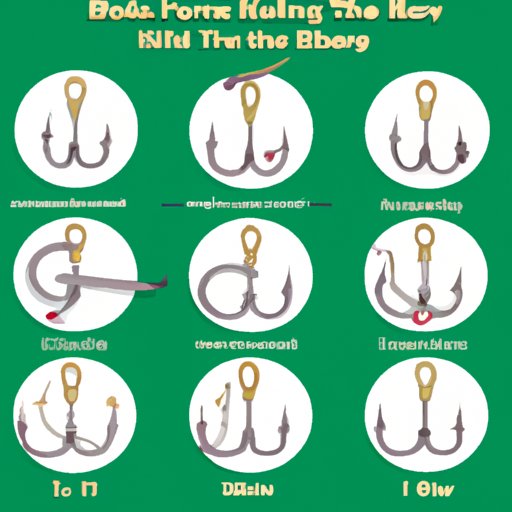
Introduction
Fishing can be a peaceful and rewarding activity, but it requires some knowledge and skills to get started. One of the most crucial skills to learn is how to tie a fish hook onto your fishing line. The problem is, there are different types of hooks and knots to use depending on the situation. In this article, we’ll cover the basics of knot tying, explore different types of hooks, fishing styles, offer a video tutorial, and share tips from fishing experts to help you become a successful angler.
Basic Knots
Before diving into the recommended knots for specific hooks and fishing styles, it’s important to know some basic knots that are used to secure fish hooks. Here are three knots that are easy to learn and effective.
The Improved Clinch Knot
This knot is commonly used and works well with most hooks and lures.
1. Pass the line through the eye of the hook and make 5-6 turns around the standing line.
2. Bring the end of the line back through the first loop formed behind the eye, then through the big loop.
3. Wet the knot and pull the standing line and the tag end to tighten the knot.
The Palomar Knot
This knot is considered one of the strongest knots, and it’s easy to tie even with cold or wet hands.
1. Double 6 inches of line and pass the loop through the eye of the hook.
2. Tie an overhand knot with the loop and hook.
3. Pull the hook through the loop.
4. Wet the knot and pull the standing line and the tag end to make the knot snug.
The Uni Knot
This knot is versatile and can be used to connect the line to the hook and to tie two lines together.
1. Double the line and pass it through the eye of the hook.
2. Make a loop and bring it toward the hook.
3. Wrap the tag end around the double line and the loop four to six times.
4. Bring the tag end back through the loop and pull the knot tight.
Knots by Type of Hook
Different types of hooks require different knots to ensure they are secure and function correctly. Here are some common hooks and their recommended knots.
Circle Hooks
Circle hooks are popular for catching fish and reducing the chance of gut-hooking the fish. Here’s how to tie the circle hook knot.
1. Pass the line through the eye of the hook.
2. Make a loose, 5-inch loop in the line’s free end.
3. Rotate the loop half a turn so it becomes wrapped around the doubled section of line.
4. Continue wrapping the loop around the doubled line until you’ve completed at least six turns.
5. Pass the line’s free end back through the small loop created in the upper part of the hook’s eye.
6. Wet the knot and gently pull both ends to make the knot snug.
J Hooks
These hooks are popular for catch-and-release fishing. Here’s how to tie the J hook knot.
1. Pass the line through the eye of the hook.
2. Tie a simple or clinch knot near the hook’s eye.
3. Run the line through the hook’s point and back around the shank, forming a loop.
4. Wrap the line around the shank, moving toward the eye, making five or six turns.
5. Run the line through the loop you created and tighten the knot.
Knots by Fishing Style
Different fishing styles require different knots, so here are some popular styles with the recommended knots to use.
Fly-Fishing
Fly-fishing requires using lightweight lures and an additional leader between the line and hook. Here’s how to tie the nail knot.
1. Overlap the tag end of your line and the leader by six inches.
2. Wind the tag end around the leader five to six times.
3. Take the tag end and pass it through the loop near the line’s end.
4. Pass the tag end and the leader tip through the big loop.
5. Wet the knot and pull both ends.
Surf-Casting
This is a method for catching fish in the ocean and requires long casts and heavy sinkers. Here’s how to tie the dropper loop knot.
1. Double over a portion of your line to form a loop and tie an overhand knot.
2. Pass the end of the loop through the knot.
3. Twist the loop and pass it through the overhand knot again.
4. Wet the knot and pull both tags.
Video Tutorial
If you’re more of a visual learner, here’s a helpful video tutorial on tying the improved clinch knot.
Tips from Fishing Experts
We’ve gathered some tips from professional anglers and avid fishers to help improve your knot-tying skills. These tips can help you tie your knots faster and make them stronger.
– Use the right knot for the hook and fishing style you’re using.
– Wet the knot before pulling it tight to reduce friction and prevent the line from breaking.
– Trim the tag end close to the knot for a neater finish and to reduce the chance of tangles.
– Practice tying knots regularly to improve your skills.
– Use quality fishing line, hooks, and equipment to ensure your knots hold up.
Conclusion
Tying a fish hook can be a challenging task, but it’s a crucial skill to master if you want to catch fish. We’ve covered the basic knots, the recommended knots for different types of hooks and fishing styles, provided a video tutorial, and shared tips from fishing experts to help you become a better angler.





